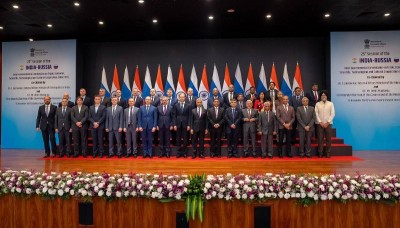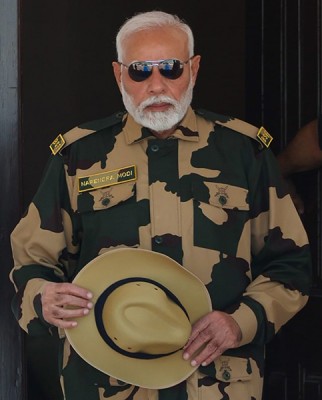 China-Pakistan
China-Pakistan
United States Institute for Peace report on deepening China–Pakistan military relations inspires calls for the West to wake up
As per a study titled The China Index 2022 conducted by the China in the World (CITW) network of the Taiwan-based anti-disinformation group Doublethink Lab, Pakistan stands at the top of a list of 82 countries over which China exercises most influence.
According to the study, which was published in December last year, China’s influence in Pakistan was most active in the domains of technology, foreign policy and military.
All these three spheres find mention in the 22 March Special Report titled ‘A Threshold Alliance: The China-Pakistan Military Relationship’ by Sameer Lalwani, senior fellow at the Stimson Center, for the United States Institute for Peace (USIP).
Lalwani’s focus, though, was on the deepening military relationship between Beijing and Islamabad.
The expanding contours of that relationship that were highlighted by Lalwani led some to question whether it dwarfed even the China Pakistan Economic Corridor (CPEC) as far as Chinese influence over Pakistan was concerned.
The strengthening Chinese dominance over Pakistan is emerging as a cause of worry for the rest of South Asia, with regional experts also calling upon the West to wake up on the issue.
The USIP Special Report avers that geopolitical shifts in South Asia over the past decade, driven by sharper US-China competition, a precipitous decline in China-India relations, and the 2021 withdrawal of US forces from Afghanistan, have pushed the Chinese and Pakistani militaries closer together. The countries’ armies and navies are increasingly sharing equipment, engaging in more sophisticated joint exercises, and interacting more closely through staff and officer exchanges. The report examines how China and Pakistan appear to be building these shared capabilities and interoperability through arms transfers, exercises, and basing. It explores China-Pakistan military cooperation through three areas: arms transfers and co-development, military diplomacy and exercises, and military basing preparations and contingencies.
The USIP says that despite China’s eschewal of formal alliances, the China-Pakistan military partnership has deepened significantly over the past decade and is approaching a threshold alliance. China has been Pakistan’s most important defense partner since the end of the Cold War. Beijing has become the leading supplier of Pakistan’s conventional weapons and strategic platforms and the dominant supplier of Pakistan’s higher-end offensive strike capabilities. China’s military diplomacy with Pakistan quantitatively and qualitatively rivals its military partnership with Russia. China and Pakistan have accelerated the tempo of joint military exercises, which are growing in complexity and interoperability. Increasingly compatible arms supply chains and networked communications systems could allow the countries to aggregate their defense capabilities.
The report adds that the prospects for China projecting military power over the Indian Ocean from Pakistan’s Western coast are growing. Chinese basing has meaningful support within Pakistan’s strategic circles. The material and political obstacles to upgrading naval access into wartime contingency basing appear to be surmountable and diminishing over time. The USIP points out that as China searches for partners and has become more open about seeking overseas military bases, which it terms “strategic strong points”, it has become increasingly eager to enhance military cooperation with two key States – Russia and Pakistan. Several China military experts regard Beijing’s strategic relationship with Islamabad as something as formidable and consequential as Beijing’s relationship with Moscow.
In the sphere of arms transfers, over the past decade, China has become Pakistan’s leading and most important provider of arms as measured by value, and Pakistan has become China’s largest and most important arms recipient, acquiring almost 40% of Beijing’s arms exports. Since 2015, China has provided nearly 75% of all of Pakistan’s imported arms (by trend-indicator value). China has grown as the leading supplier of the Pakistan Army’s combat power. It is the undisputed dominant supplier of the Pakistan Army and Pakistan Air Force (PAF), and although the Pakistan Navy has effectively diversified, China is still its largest provider of major combat platforms to it. For example, despite the historical attention paid to Pakistan’s three F-16 fighter squadrons, each comprising 18–24 of its most advanced combat aircraft, Chinese platforms such as the JF-17 multirole combat aircraft make up the largest share of Pakistan’s modern fighter fleet, while the China-supplied F-7, designed for short-range air-to-air combat, forms the backbone of the legacy attack aircraft fleet. Chinese-origin equipment also constitutes the majority of the Pakistan army’s offensive armor and support units used in fire missions, such as artillery and rocket launchers. Increasingly, compatible supply chains for armor, artillery, and rocket launchers; networked communications and information systems; and interoperable air defenses and electronic warfare systems have moved Pakistan and China closer to being able to aggregate their considerable military capabilities should they make the strategic decision to do so.
Lalwani notes that perhaps China’s most important contribution to Pakistan’s defense capabilities is its assistance in the nuclear weapons program and broader strategic deterrence elements. Between the 1970s and the 1990s, China helped Pakistan with nuclear enrichment, including providing feedstock for Pakistan’s enrichment centrifuges, operating Pakistan’s heavy water reactor, constructing plutonium-producing reactors, and directly transferring weapons-grade highly enriched uranium. China helped with Pakistan’s nuclear weaponization, including bomb designs and the development of high-explosive components; and with nuclear weapons delivery capabilities, including the development and transfer of solid-propellant missiles as a nuclear delivery platform. More recently, China has further advanced Pakistan’s strategic defense capabilities by providing enabling features such as space access and advanced optical tracking systems for the development of multiple independent re-entry vehicles.
Despite the asymmetrical relationship between China and Pakistan, technology transfers have not been one-way only. Pakistan facilitated China’s missile program through the transfer of unexploded Tomahawk missiles that landed in Afghanistan; reverse engineering helped China create its air-launched KD-20 cruise missile and the ground-launched DH-10 cruise missile. China then used this technology to help Pakistan develop its Babur missiles. Moreover, Pakistan is believed to have given China access to stealth technology by providing samples of the Black Hawk helicopter that crashed during the 2011 Abbottabad mission to eliminate Osama Bin Laden. In August 2022, Pakistan’s then Army Chief, General Qamar Javed Bajwa, characterized China’s and Pakistan’s militaries as “brothers in arms” working together to safeguard collective interests.
Over the past 20 years, China has overtaken all other countries as the leading supplier of high-end defense platforms to all of Pakistan’s military services. At the same time, the volume and quality of military-to-military interactions have provided additional indicators of the growing military relationship. The PLA’s military engagement with Pakistan has been one of the most significant relationships it has cultivated over the past two decades. The routinization of high-complexity military exercises presages a level of procedural and command interoperability that can generate synergies between the two forces in future missions and operations. The USIP report observed, however, that China and Pakistan approaching a new military relationship threshold may compel their competitors and adversaries to jointly plan for combat on a dual front. This strategic dilemma has already been observed by New Delhi, but Washington may also need to consider it in future defense planning.
Ayesha Siddiqa, Senior Fellow at the Department of War Studies at King’s College, London, who is an expert on Pakistan’s military and has written the book Military Inc. about it, in an article earlier this week titled ‘Pakistan has walked dangerously deep into Chinese grip. Wake up, West’ described the China-Pakistan relationship as two-dimensional: (a) the newer CPEC relation, which is driven by Beijing’s need for economic projection and of Pakistan’s economic development and has lesser potential, and (b) the time-tested and traditional military security linkage that is not one-sided but caters as much to China’s needs as Pakistan’s. The two elements may be connected, but have deliberately been kept separate to ensure that the newer economic relationship does not affect the older military ties. The CPEC relationship was developed on the shoulders of a more stable military security relationship that revolves mainly around arms and technology transfer between the two Asian allies. Siddiqa stressed that it was not the other way around.
Referring to Lalwani’s description of a ‘threshold alliance’ Siddiqa argued that the threshold relation does not extend to the shared geo-strategic goals of China and Pakistan, for which Kashmir is the contention. She pointed out that during the Kargil war in 1999, the Pakistani delegation consisting of the then Prime Minister Nawaz Sharif and Army Chief Pervez Musharraf went to Washington to negotiate withdrawal after their visit to Beijing where they did not get any encouragement to persist with the military venture. According to former Pakistan Air Chief Marshal P.Q. Mehdi, who was part of the delegation, the PLA Air Force chief told him that he was happy to offer any amount of technology if there was a nod from the civilian leadership, something he eventually did not receive. Siddiqa asserted, however, that Beijing’s disagreement on Kargil did not mean that it will stop building its ally’s military muscle by providing its technology to be used in contesting India, irrespective of Pakistan’s financial capacity.
Siddiqa also underlined that while China has been one of Pakistan’s key arms suppliers since the 1960s, the dependence is today deeper than ever before because of lack of choice. Islamabad does not have the money to buy off-the-shelf the same way it did during the 1970s after its second war with India, nor is it part of any alignment that would reap major military modernization.
However, the growing technology dependency on a single source, China, will also impact the overall strategic culture of Pakistan’s armed forces that up until now is part of the western security constellation. That said, Pakistan does not go to Europe and the US for weapons training any more. Reduced general training in the West and increased weapons training for operators in China is likely to create a tilt within the organization. Siddiqa wrote, “Let’s not forget that those who visit return impressed with Chinese development and pace of growth despite there being no opportunities to relocate to China”. Nevertheless, Siddiqa also pointed out that “the West has greater soft power as demonstrated by the presence of Pakistani civil and military leadership and their families in the US or/and European capitals instead of China. I haven’t at least heard of sons and daughters of senior Generals living in China despite the relationship being ‘higher than mountains, deeper than ocean and sweeter than honey’”. She concluded with the prediction that “My guess is that at some stage this may add to a chasm within the organization”.
Siddiqa also believes that given Pakistan’s dire economic condition and the western ability to use international financial institutions such as the Financial Action Task Force (FATF) and the International Monetary Fund (IMF) to moderate behaviour of resource-dependent States, in all likelihood countries such as Pakistan may not slip entirely into the Chinese camp. She revealed that knowledgeable sources had told her that one of the reasons China was not going out of its way to help Pakistan during its ongoing severe financial emergency was due to “some trust deficit”.
The big dilemma for Pakistan in this milieu lies in its clear awareness that its dependence on China is bound to persist and grow till such time as Islamabad’s issues with New Delhi remain unresolved.
Support Our Journalism
We cannot do without you.. your contribution supports unbiased journalism
IBNS is not driven by any ism- not wokeism, not racism, not skewed secularism, not hyper right-wing or left liberal ideals, nor by any hardline religious beliefs or hyper nationalism. We want to serve you good old objective news, as they are. We do not judge or preach. We let people decide for themselves. We only try to present factual and well-sourced news.







